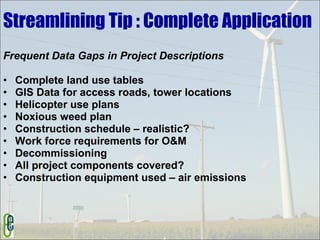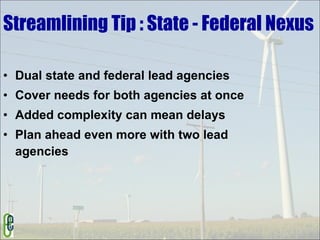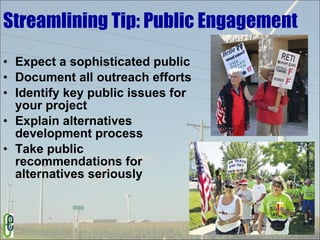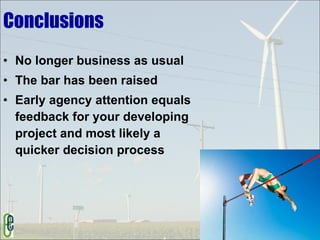Streamlined Permitting for Renewable Energy Transmission
- 1. Renewable Energy Transmission Bridging the Gap Intersection of Transmission Lines and Environmental Laws CLE International Ritz Carlton, Denver March 19, 2010
- 2. Streamlining State and Federal Permitting for Transmission lines Daniel Belin ecology & environment Boulder, CO March 19, 2010
- 3. Streamlining Background: Regional Issues Permitting Process: Federal - State -Local Strategies for expedited processes
- 4. Be The Early Bird…
- 5. Extra High Voltage Transmission Source – Wyoming Infrastructure Authority, 2008
- 6. Wyoming Core Habitat Areas
- 7. Policy Conflict “By putting these renewable energy projects on a fast track, we are managing our public lands not just for conventional energy development but also for environmentally responsible renewable energy production that will power our clean energy future.” Secretary of Interior, Ken Salazar November 5, 2009
- 8. Policy Conflict “Large-scale wind energy facilities continue to be proposed in Wyoming without adequate information to evaluate major environmental consequences for wildlife, or to support planning and design considerations to minimize those impacts…Lacking specific research, it is prudent to expect that industrial-scale wind farms will have significant impacts…” Wyoming Game and Fish Department Recommendations for Wind Energy Development
- 9. Pre- application meeting Submit preliminary application County scheduled public hearing with P&Z Board and BOCC Submit final 1041 application 30 day public notice and comment period 30 day public notice and comment period Total: 3-4 Months Joint public hearing with Planning and Zoning Board and BOCC P&Z Board hold meeting on same day and issue recommendations to BOCC BOCC Meeting Final Approval issued within 7 days Permitting – County: Colorado 1041
- 10. Permitting – State: Wyoming ISC 0-2 Months 6-9 Months 3 Months 0-2 Months 1 Month Total: 18 Months Preliminary Discussions Pre- Application Period Application Submittal Period Hearing and Service of Decision Appeal Window
- 11. Permitting – Federal : NEPA EIS Application Notice of Intent Published Public Scoping Draft EIS Comment Period / Agency Review Final EIS Comment Period / Agency Review Record of Decision (ROD) Appeal Period 30 days 45 days 6-9 months 45 days 6-9 months 45 days Total: 18-24 months
- 12. Pre-filing: Sewing Up the Slack Pre-Filing Process: 3rd party consultant on board before application filed Early MOUs, cost recovery agreements Early issue resolution More complete application California PUC Application Filed Draft EIR Published “ Transition Time” Saved With Pre-filing
- 13. Pre-filing: Early Coordination To keep schedule moving: Hold ID team meeting before application submittal Prepare summarized impact tables Resource specific ID team meetings prior to administrative draft Plan ahead for HQ review
- 14. Pre-filing: Process Benefits Early ID of issues/alternatives with agency leads Avoids duplication Jump start on cultural/bio consultations and requirements Fewer surprises Application more likely to be deemed complete
- 15. Pre-Filing: Agency Agreement BLM allows early MOUs, Cost Recovery Agreements and site visits before POD filing Western – no formal pre-filing process but early discussions/public engagement expected $3+ billion in loan guarantees and partnering opportunities
- 16. US Forest Service Issue early study permits Allows early access to project areas Applicants need to do their homework – know their Forest Plan Pre-Filing: Agency Agreement
- 18. Streamlining Tip : Get People Together Get your team talking details for a complete Project Description
- 19. Streamlining Tip : Complete Application Frequent Data Gaps in Project Descriptions Complete land use tables GIS Data for access roads, tower locations Helicopter use plans Noxious weed plan Construction schedule – realistic? Work force requirements for O&M Decommissioning All project components covered? Construction equipment used – air emissions
- 20. Streamlining Tip : State - Federal Nexus Dual state and federal lead agencies Cover needs for both agencies at once Added complexity can mean delays Plan ahead even more with two lead agencies
- 21. Streamlining Tip: Public Engagement Expect a sophisticated public Document all outreach efforts Identify key public issues for your project Explain alternatives development process Take public recommendations for alternatives seriously
- 22. Streamlining Tip: Alternatives Track all alternatives screened Address system alternatives (230kV vs. 500kV) Develop an adequate range of alternatives: BLM to require 3 to 4 alternatives for renewable projects Agencies expect public engagement to develop alternatives for contentious projects
- 23. Conclusions No longer business as usual The bar has been raised Early agency attention equals feedback for your developing project and most likely a quicker decision process
- 24. … and Get That Worm!
- 25. Thank you. Daniel Belin, AICP ecology & environment 4888 Pearl East Circle, Suite 108 Boulder, CO 80503 [email_address] (303) 443-3282
Editor's Notes
- #3: Good afternoon and thank you for this opportunity to speak on the nexus of environmental laws and renewable energy transmission. So far in this conference we’ve heard about many of the components of transmission infrastructure development – from cost allocation, grid configuration, land rights, smart grid, and others important issues. For my talk I would like to focus on primary area where environmental regulations meet infrastructure development – permitting. And more specifically I would like to talk about streamlining the permitting process.
- #4: I’ll start with some background on some of the larger regional issues, and then review the typical permitting process that developers face, and finish with some strategies that we have found successful in expediting that process.
- #5: And if you remember one thing from my talk – it is “Be The Early Bird”! Throughout the siting and permitting projects that we’ve worked on, the ones that have gotten to construction the quickest have been the ones willing to invest time and resources addressing the issues early.
- #6: So to start with a little background… Most of the transmission lines that you saw from Mr. Ellenbecker’s presentation have ostensibly been established to export Wyoming wind to load centers to the South and West. These wind resources happen to be co-located in numerous areas with the most critical habitat for Sage Grouse. So in this slide, you see the High Plains Express, Wyoming-Colorado Intertie, TransWest Express, Gateway South, Gateway West, Overland Intertie, and others. The High Plains Express and WCI lines as proposed are outside of sage grouse core areas, but others are likely to intersect those areas.
- #7: And this slide shows the current conflict between the greater Sage Grouse and renewable energy development. This figure shows the Class IV and above wind resources (in blue) overlaid on top of the Sage Grouse Core areas (in black crosshatch) that have been established by the State of Wyoming. If you’ll notice the region between Laramie, Casper, Rock Springs, and Riverton contains a large portion of this conflict. And these wind resources are some of the primary drivers behind the push for large, utility scale renewable energy transmission. The Bureau of Land Management is the lead federal regulatory agency on most of these large lines, but these core areas are a state-level designation. So these projects will be working with multiple scales of permitting, and the differences between federal mandates and state concerns can often be significant.
- #8: This difference can be highlighted by the designation of “fast track” renewable energy projects on federal land. Secretary Salazar announced this initiative last year for projects that should be far enough along in the process to be able to be permitted by December 2010.
- #9: This project will be subject to state wildlife regulations. The slide here is a lot of words, but it is a statement from the Wyoming Game and Fish department that they released at roughly the same time Salazar announced the fast track initiative. And what WGFD is saying is that they have no intention of expediting permitting. So that’s the basic problem that we are seeing throughout the west. Federal MOUs and mandates being established and state regulations coming out that are in conflict with these initiatives. In order to address this disconnect, it helps to first look at the permitting process in general and then talk about specifics for streamlining.
- #10: We’ll start local, and this is Colorado’s County 1041 permit process. This process begins with pre-application consultation, application submittal, public hearings, and final ruling This is the timeline on paper for Huerfano county, but with large energy infrastructure projects we have found this process to be much longer and more akin to the ISC timeline in Wyoming.
- #11: And here’s a closer look at the Wyoming State permitting process for all major infrastructure projects. While the details of an ISC hearing and their process differs in the specifics from the 1041 process or NEPA, the milestones and processes are similar.
- #12: So this is the standard federal permitting process through NEPA. As a quick background, NEPA is the National Environmental Policy Act of 1969 and it mandates analysis of potential environmental impacts on major “federal actions”. So if a project has a federal nexus – either it cross federal land, uses federal funds, or involves federal legislation, NEPA is triggered. And for any new energy infrastructure development, the level of NEPA analysis will be either en Environmental Assessment (EA) or an Environmental Impact Statement (EIS). The difference between the two is the possibility of significant environmental impacts. If there is a potential for significant impacts and EIS, which is the more rigorous of the two is mandated. And this slide shows the timeline for an EIS. The timeline varies by lead agency and how they conduct NEPA. This timeline can be achieved, but in our experience it often depends on the time invested by the applicant before the application is filed. For the projects who have been the early bird, they have invested time and resources in this first phase before they submit their application. These permitting processes have several issues that can slow down a timeline New alternatives can pop up during scoping Data gaps can be found after the DEIS requiring more studies And their can be a gap between application and review as contractors get put in place We have found that a pre-filing approach to these processes best addresses these roadblocks.
- #13: And we have most recently been applying that process in California, where the CPUC was having a difficult time meeting their schedules. E&E recognized that a lot of time is being wasted in transition between preparing the application and really getting moving on preparation of the EIR. Often months are spent getting a 3 rd party contractor on board and up to speed and then resolving rounds of data requests. By completing a pre-filing process the gap is stitched up. 3 rd party is already on board – that alone saves a couple of months in the middle due to lengthy contracts approvals process at CPUC Agencies/resource have completed site visits and touched on key issues and alts ahead of time so that info is in the application.
- #14: Here are some of the good things that can happen under pre-filing. These early team building steps are very important especially with agency planning staff cutbacks. Overextended agency resource staff members are trustees for these state/federal resources You want to be engaging them and on their RADAR early and often. These “plan ahead” steps have been very helpful
- #15: Pre-filing is still new at CPUC. But it is not a panacea - pre-filed projects can still be delayed like any other project Eternally vigilant on the details. Though project proponents may require more time up front to complete their permit applications, quicker agency decision processes are more likely to result than if you don’t pre-file.
- #16: Federal Offices Overwhelmed. Delays since Surveys/studies may not all be present when POD is filed Old Model - No agency involvement before application and Cost Recovery Agreement complete so do those early Consultant prepares all sections of EIS and Difficulty getting resource staff to review EIS sections – early meetings needed Need to make your real projects stand out and Federal agencies are willing to talk.
- #19: Transmission projects are complex with lots of planners, environmental professionals, and engineers. Application needs to present one picture.
- #20: Do your homework. A complete PD is what the 3 rd party consultant really need to do the EIR or EIS.
- #21: Tip – how to deal with State and NEPA at the same time? Best benefit of streamlining for a EIR/EIS is getting the Fed reps in the field to talk key issues before filing so those alts and survey details are covered in the application before they resource specialist find deficiencies in an Admin Draft. Sometime directions can be unclear coming from two leads so get choices in front of the PMs so they know their options and can make a decision to move the document forward.
- #22: Newly sophisticated public on top of regional forecasts as it relates to the purpose and need of a project. They want to know if lines are carrying renewable power and if the goals of the project can be accomplished by doing something else. So, Lead agencies want to know you have done your homework with public involvement. Because bad press can certainly contribute to pulling the plug.
- #23: Alternatives tied to public process. Explain alternative screening process in application. Ratings, capacity needed – not obvious to the public The agencies and the public expect to have a say on alts considered
- #24: Though project proponents may require more time up front to complete their permit applications, quicker agency decision processes are likely to result from implementing these early permitting best practices. Will just take longer if you don’t pre-file. Don’t get left behind. Do your homework. This level of detail and early action is now required to get a project through.
- #25: Get the worm - get a decision on your project on schedule by engaging early and planning ahead…. Be the envy of your competitors.
- #26: Thank you. [email_address] (303) 443-3282 ecology and environment 4888 Pearl East Circle, Suite 108 Boulder, CO 80503
























![Thank you. Daniel Belin, AICP ecology & environment 4888 Pearl East Circle, Suite 108 Boulder, CO 80503 [email_address] (303) 443-3282](https://image.slidesharecdn.com/belinstreamlinedpermittingv2-12708510216715-phpapp02/85/Streamlined-Permitting-for-Renewable-Energy-Transmission-25-320.jpg)